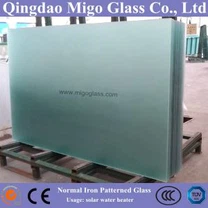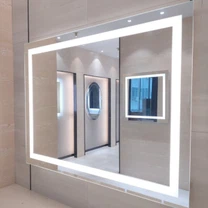Padel is a fast-paced racket sport that has gained significant popularity worldwide. One of the key components of a padel court is the glass used in its construction. The glass not only provides a clear, unobstructed view of the game but also ensures the safety and durability of the court. In this comprehensive guide, we will explore the different types of glass used in padel courts, their specifications, features, benefits, and market analysis.
1. Types of Glass for Padel Courts
1.1 Tempered Glass
1.1.1 Specifications
Thickness: The standard thickness for padel court glass is 10mm or 12mm. These thicknesses provide the necessary strength and safety to withstand the rigors of the game.
Size: A typical padel court requires approximately 108 square meters of glass to cover the necessary playing area. The glass sizes are usually 3000x2000mm, 2995x1995mm, or 1995x1995mm.
Processing: The glass undergoes cutting, edge polishing, hole drilling, and tempering. This process ensures that the glass is smooth, safe, and durable.
1.1.2 Features
High Strength: Tempered glass is 3-5 times stronger than ordinary glass, making it highly resistant to impacts.
Safety: If broken, tempered glass shatters into small, blunt pieces, reducing the risk of injury.
Clarity: The glass is highly transparent, ensuring a clear view of the game for players and spectators.
Acoustic Attenuation: Tempered glass reduces noise levels by 33 dB, making it ideal for both recreational and professional use.
1.1.3 Benefits
Durability: Tempered glass is resistant to scratches, weather conditions, and impacts, ensuring a longer lifespan for the court.
Safety: The high strength and safety features of tempered glass make it the preferred choice for padel courts.
Aesthetic Appeal: The clear and transparent appearance of tempered glass enhances the visual appeal of the court.
Customization: Clubs and venues can customize the glass with logos or designs, adding a personal touch and enhancing branding.
1.2 Laminated Glass
1.2.1 Specifications
Thickness: Laminated glass typically consists of two layers of glass bonded together with a PVB interlayer. Common thicknesses include 6+6mm and 8+8mm.
Size: The glass sizes are similar to those of tempered glass, with common dimensions being 3000x2000mm, 2995x1995mm, or 1995x1995mm.
Processing: Laminated glass undergoes cutting, edge polishing, hole drilling, and lamination. This process ensures that the glass is strong and safe.
1.2.2 Features
High Strength: Laminated glass is even stronger than tempered glass, providing enhanced resistance to impacts.
Safety: If broken, the glass pieces remain bonded to the PVB interlayer, preventing them from falling and causing injury.
Clarity: Laminated glass maintains high transparency, ensuring a clear view of the game.
1.2.3 Benefits
Superior Safety: The PVB interlayer ensures that the glass remains intact even if broken, providing the highest level of safety.
Durability: Laminated glass is highly resistant to weather conditions and impacts, making it suitable for both indoor and outdoor courts.
Aesthetic Appeal: The clear and transparent appearance of laminated glass enhances the visual appeal of the court.
2. Market Analysis
2.1 Global Padel Court Market Segmentation
2.1.1 By Court Type
Indoor Courts: These courts are enclosed and often climate-controlled, making them suitable for year-round play regardless of external weather conditions. They are particularly appealing in regions with varying seasons where outdoor play might be limited.
Outdoor Courts: These courts are set up in open-air environments, allowing players to enjoy the sport in natural settings. They are often more cost-effective to build and maintain, making them popular in regions with favorable climates.
2.1.2 By Material Type
Glass: Glass padel courts are highly popular due to their aesthetic appeal and ability to create a vibrant playing environment. They allow for a clear view of the game from all angles, enhancing the spectator experience.
Metal: Metal is another material used in padel court construction, offering durability and strength. However, it may not provide the same level of transparency as glass.
Synthetic: Synthetic materials are used for the playing surface of padel courts, providing a consistent and reliable playing experience.
2.2 Market Trends
Panoramic padel courts are gaining popularity due to their distinctive design, which offers spectators an unobstructed view of the game. These courts are constructed using high-quality tempered or laminated glass, ensuring durability and safety.
3. Customer Reviews
3.1 Positive Feedback
Customers have reported high satisfaction with the durability and safety of tempered and laminated glass. The clear visibility and modern aesthetic have also been praised, enhancing the overall playing experience.
3.2 Professional Reviews
Industry experts recommend tempered glass for its balance of strength, safety, and cost-effectiveness. For outdoor and high-intensity environments, 12mm tempered glass is often recommended. Laminated glass is the preferred choice for courts requiring the highest level of safety.
Understanding the different types of glass used in padel courts is crucial for ensuring a safe, durable, and visually appealing playing environment. Tempered glass is the most common choice due to its strength, safety, and cost-effectiveness. Laminated glass offers superior safety and durability, making it ideal for high-intensity environments. ComfortGlass is a lightweight and cost-effective alternative, suitable for clubs with a limited budget.
Whether you are a club owner, facility manager, or a padel enthusiast, choosing the right glass for your padel court is a wise decision. It not only enhances the playing experience but also adds value to your facility. Contact us today to learn more about our glass solutions and take the first step towards creating a world-class padel court.






